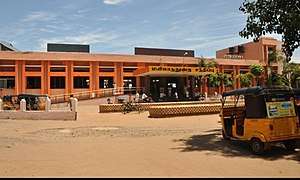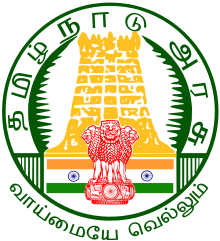Mayiladuthurai
Mayiladuthurai (formerly known as Mayavaram or Mayuram) is a major town in Mayiladuthurai district in Tamil Nadu, India and the headquarters of the district. The town is located at a distance of 281 km (175 mi) from the state capital, Chennai. Mayiladuthurai is known for the Mayuranathaswami Temple, a prominent Shaivite shrine. It is well connected by road and rail transport. Mayiladuthurai serves as a major junction in main line connecting Chennai with Trichy.
Mayiladuthurai | |
|---|---|
Town | |
 Mayuranathaswami Temple | |
| Coordinates: 11.10°N 79.65°E | |
| Country | |
| State | Tamil Nadu |
| District | Mayiladuthurai |
| Government | |
| • Type | Selective Grade Municipality |
| • Body | Mayiladuthurai Municipality |
| • chairman | Jayaraman |
| Area | |
| • Total | 11.27 km2 (4.35 sq mi) |
| Elevation | 54.25 m (177.99 ft) |
| Population (2011) | |
| • Total | 85,632 |
| • Density | 7,600/km2 (20,000/sq mi) |
| Languages | |
| • Official | Tamil |
| Time zone | UTC+5:30 (IST) |
| PIN | 609001 |
| Telephone code | 91 4364 |
| Vehicle registration | TN-82 |
Mayiladuthurai was ruled by Medieval Cholas and subsequently ruled by various dynasties, including the Vijayanagar Empire, Delhi Sultanate, Thanjavur Nayaks, Thanjavur Marathas and the British Empire. Mayiladuthurai was a part of the erstwhile Tanjore district until India's independence in 1947 and Thanjavur district until 1991 and subsequently a part of the newly formed Nagapattinam district. The town is known for agriculture, metal working and weaving. The region around Mayiladuthurai has considerable mineral deposits.
Mayiladuthurai is administered by a municipality established in 1865. As of 2008, the municipality covered an area of 11.27 km2 (4.35 sq mi). Mayiladuthurai comes under the Mayiladuthurai assembly constituency which elects a member to the Tamil Nadu Legislative Assembly once every five years and it is a part of the Mayiladuthurai constituency which elects its Member of Parliament (MP) once in five years. Roadways are the major mode of transportation to the town and it also has rail connect Coimbatore, Madurai, Tiruchirapalli Thanjavur from Mayiladuthurai, while the nearest airport, Pondicherry Airport, is located 116 km (72 mi) from the town.
Etymology
Mayiladuthurai's name is derived from the Mayura or Mayil (peacock) form in which the Hindu goddess Parvathi worshipped the Hindu god Shiva at this place.[1][2] While previously known by its Sanskrit name Mayuram, meaning "peacock town", the town has been recently de-Sanskritized to its Tamil translation Mayiladuthurai as a result of a petition by the Mayuram municipality to the Government of Tamil Nadu in the wake of the Dravidian Movement.[3] The Mayuranathaswami Temple dedicated to the goddess Parvathi is one of the most important Hindu temples in the town. There is a statue depicting goddess Parvathi in a peahen form worshipping a linga, the symbol of the god Shiva to the west of the eastern wall of the temple.[1]
History
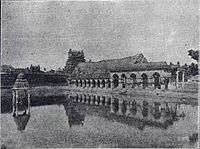
Mayiladuthurai is of significant antiquity, its oldest extant temples dating to the time of the Medieval Cholas. The region, however, is known to have been inhabited since the 3rd millennium BC. Sherds of megalithic black and red ware have been found at Akkur, 14 km (8.7 mi) to the east of Mayiladuthurai.[4] In 2006, artifacts with Indus Valley signs dated between 2000 and 1500 BC were found at the nearby village of Sembiyankandiyur.[5][6] There have been references to Mayiladuthurai in the works of the 7th century Saivite saint Sambandar.[7] The Thanjavur Nayak king Raghunatha Nayak constructed mandapams in Mayiladuthurai.[8] During the 17th and 18th centuries AD, Mayiladuthurai was ruled by the Thanjavur Marathas who invited Brahmins from the Telugu, Kannada and Maratha countries to settle in the region and gave large extents of land to them.[9] In 1799, Mayiladuthurai, was ceded to the British East India Company, along with the rest of the Thanjavur Maratha kingdom, by the Thanjavur Maratha ruler Serfoji II.[10] Mayiladuthurai prospered under British rule emerging as an important town in Tanjore district. Carnatic musicians Madurai Mani Iyer and Gopalakrishna Bharathi and Samuel Vedanayagam Pillai, who wrote the first Tamil novel Prathapa Mudaliar Charithram were connected with Mayiladuthurai while Tamil writer Kalki Krishnamurthy, M.S.Udhaya Moorthy studied at the Municipal High School in Mayiladuthurai.[11] According to local folklore, Mayiladuthurai was associated with Hindu holy men called "Siddhars".[11] To this day, a neighbourhood of Mayiladuthurai is called Siddharkaadu.[11] When the Tanjore district was trifurcated in 1991, Mayiladuthurai was transferred to the newly formed Nagapattinam district.On 24 th of March 2020 Mayiladuthurai was declared as a new district By the Chief minister Of Tamil Nadu on the assembly.
Geography and climate
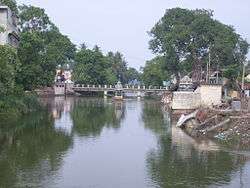
Mayliladuthurai is situated at a distance of 281 kilometres (175 mi) from Chennai and 130 kilometres (81 mi) from Tiruchirappalli.[13] The town is located at 11.10°N 79.65°E.[14] Situated at a distance of 24 kilometres (15 mi) from the Bay of Bengal coast, the town is situated at an altitude of barely 10 metres (33 ft) above mean sea level.[13] The Kaveri River runs through the town bisecting it into Uttara Mayuram and Mayuram proper. Most of the town lies to the south of the river and the Mayuranathaswami Temple lies a mile to its south. There is a bathing ghat on the Cauvery river. Agriculture is the most widely practised occupation.
The climate of Mayiladuthurai is similar to the climate prevailing in the rest of the Cauvery Delta. The average maximum temperature is 39.4 degrees Celsius while the average minimum temperature is 32.8 degrees Celsius.[13] The average annual rainfall is 1,125 mm.[13]
Administration and politics
| Municipality Officials | |
|---|---|
| Chairman | Bhavani Srinivasan[15] |
| Commissioner | K. Parthiban[16] |
| Vice Chairman | N. Selvaraj[17] |
| Elected Members | |
| Member of Legislative Assembly | V.Ratha Krishan[18] |
| Member of Parliament | S.Ramalingam[19] |
The town of Mayiladuthurai is administered by a municipal council which was created in 1866 as per the Town Improvements Act 1865. The council initially had eleven members.[20] This was increased to 18 in 1883 and currently stands at 36.[20][21]
As of 2008, the municipality covered an area of 11.27 km2 (4.35 sq mi) and had a total of 36 members. The functions of the municipality is devolved into six departments: General, Engineering, Revenue, Public Health, Town planning and the Computer Wing. All these departments are under the control of a Municipal Commissioner who is the supreme executive head.[22] The legislative powers are vested in a body of 36 members, one each from the 36 wards.[23] The legislative body is headed by an elected Chairperson assisted by a Deputy Chairperson.[24] There are a total of four revenue villages with Mayiladuthurai - Thiruvilandur, Dharmapuram, Nanchilnadu and Kornad.[25] The municipality has allocated a budget of ₹2,183,350,000 for the year 2010–11.[26]
Mayiladuthurai is represented in the Tamil Nadu Legislative Assembly by the Mayiladuthurai state assembly constituency seat.[27] N. Kittappa of the Dravida Munnetra Kazhagam served as member for the Mayiladuthurai legislative constituency for four consecutive terms from 1967 to 1984.[28][29][30][31] The Indian National Congress has won the seat four times (1957,[32] 1962,[33] 1991[34] and 2006[35]), the Dravida Munnetra Kazhagam, five times (1967,[28] 1971,[29] 1977,[30] 1980,[31] 1989); the Anna Dravida Munnetra Kazhagam,[36] Tamil Maanila Congress (Moopanar)[37] and the Bharatiya Janata Party,[38] once each. Mayuram assembly constituency is part of Mayiladuthurai Lok Sabha constituency.[39]
In the national parliament, Mayiladuthurai is a part of the Mayiladuthurai (Lok Sabha constituency), which has six assembly constituencies – Mayiladuthurai, sirkali (SC), Poompuhar, Thiruvidaimarudur (SC), Kumbakonam and Papanasam. The constituency was constituted during the third Lok Sabha (lower house) as Mayuram until the 1980 elections, when it was renamed Mayiladuthurai.[40][41] During the first elections in 1957, Mayiladuthurai was part of Chidambaram constituency and was held by the Indian National Congress party.[42] The current Member of Parliament from the constituency is R.K. Bharathi Mohan of the AIADMK party.[19] From 1962, the Mayiladuthurai parliament seat was held by the Dravida Munnetra Kazhagam (DMK) twice between 1967 and 1971,[43][44] and from 1971 to 1977,[45] Tamil Maanila Congress for two terms between 1998 and 1999,[46] [47] and 1996 to 1998,[48] Anna Dravida Munnetra Kazhagam twice during 2009 and 2014, Indian National Congress for eight terms during 1962–67,[40] 1977–80,[45] 1980–84,[41] 1984–89,[49] 1989–91,[50] 1991–96,[51] 1999–2004,[47] and 2004–09.[52]
Popular Communist leader K. Ananda Nambiar represented Mayiladuthurai in the Lok Sabha from 1951 to 1957.[53] Mani Shankar Aiyar who served as a minister in India's cabinet was elected to the Parliament from the Mayiladuthurai Lok Sabha constituency in the 1991,[54] 1999[55] and 2004 elections.[56] The Mayiladuthurai Lok Sabha constituency was enlarged in 1977 and the Assembly segments of the abolished Kumbakonam Lok Sabha constituency were included in it as per the deliberations of the delimitation committee.
Utility Services
Potable water is provided by the municipality. Mayiladuthurai's main source of water in the Kollidam River.[57] A total of 7.50 MLD are pumped out every day from five water tanks located in various parts of the town.[57] About 104 metric tonnes of solid waste is generated everyday, while 85 metric tonnes are collected from the town every day by door-to-door collection and subsequently the source segregation and dumping is carried out by the sanitary department of the municipality.[58] There is limited underground drainage system in the town and the major sewerage system for disposal of sullage is through septic tanks, open drains and public conveniences.[59] The municipality maintains a total of 39 km (24 mi) of surfaced storm water drains and 4 km (2.5 mi) kutcha drains in Mayiladuthurai.[59][60] There are five government hospitals that include a maternity and a veterinary hospital and seventeen private hospitals and clinics that take care of the health care needs of the citizens.[61] There are a total of 3,262 street lamps in Mayiladuthurai: 2 high mast lamps, 2 mini high mast lamps, 624 sodium lamps, 2,334 tube lights and 47 CFL lamps.[62] The municipality operates four markets, namely a vegetable market, weekly market, farmer's market (uzhavar santhai) and fish market that cater to the needs of the town and the rural areas around it.[63]
Demographics
| Year | Pop. | ±% |
|---|---|---|
| 1871 | 21,165 | — |
| 1881 | 23,044 | +8.9% |
| 1891 | 23,766 | +3.1% |
| 1901 | 24,276 | +2.1% |
| 1911 | 27,121 | +11.7% |
| 1921 | 28,617 | +5.5% |
| 1931 | 31,887 | +11.4% |
| 1941 | 32,670 | +2.5% |
| 1951 | 43,436 | +33.0% |
| 1961 | 51,393 | +18.3% |
| 1971 | 60,195 | +17.1% |
| 1981 | 70,019 | +16.3% |
| 1991 | 76,837 | +9.7% |
| 2001 | 84,290 | +9.7% |
| 2011 | 85,632 | +1.6% |
| * 1871-1931:[64] | ||
According to 2011 census, Mayiladuthurai had a population of 85,632 with a sex-ratio of 1,045 females for every 1,000 males, much above the national average of 929.[67] A total of 7,720 were under the age of six, constituting 3,883 males and 3,837 females. Scheduled Castes and Scheduled Tribes accounted for 5.87% and .57% of the population respectively. The average literacy of the town was 83.55%, compared to the national average of 72.99%.[67] The town had a total of 21929 households. There were a total of 29,855 workers, comprising 321 cultivators, 707 main agricultural labourers, 734 in house hold industries, 23,004 other workers, 5,089 marginal workers, 74 marginal cultivators, 485 marginal agricultural labourers, 246 marginal workers in household industries and 4,284 other marginal workers.[66] As of 2001, there are 26 slums in Mayiladuthurai with a total population of 32,381.[25]
The density of population is higher in the core areas along the banks of river Cauvery compared to the peripheral areas.[68] As of 1996, a total 498.84 ha (4.9884 km2) (44.27%) of the land was used for residential, 68.87 ha (0.6887 km2) (6.11%) for commercial, 6.33 ha (0.0633 km2) (0.56%) for industrial, 22.35 ha (0.2235 km2) (1.98%) for educational, 24.27 ha (0.2427 km2) (2.16%) for public & semi public purposes and 506.35 ha (5.0635 km2) (44.92%) of agricultural area.[69] As of 2008, there were a total of 26 notified slums, with 16,434 comprising 13% of the total population residing in those.[70] The municipal data, however, pointed out an increase in population in slum areas.[68]
Hinduism is the major religion followed in Mayiladuthurai and Tamil is the major language spoken.[71] A vast majority of the populace is engaged in agriculture.[25] About 15 percent of the total working population is engaged in trade while 25 percent is engaged in other commercial activities.[25] As per the religious census of 2011, Mayiladuthurai had 88.69% Hindus, 6.38% Muslims, 4.19% Christians, 0.04% Sikhs, 0.03% Buddhists, 0.32% Jains and 0.35% following other religions.[72]
Economy
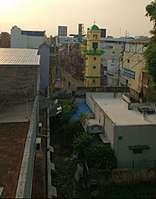
The economy of Mayiladuthurai is primarily agro-based.[73] The main products of Mayiladuthurai are rice, coconuts and plaintains.[74] Confectioneries, printing presses, vehicle manufacturing units and rice mills are the major industries in Mayiladuthurai.[73] Industrial workers form barely 27.14 percent of the town's population.[73] Mayiladuthurai is known for a unique variety of cloth known as the "Kornad cloths" which derives its name from the suburb of Kornad where they are manufactured.[74][75] These cloths are made up of a mixture of cotton and silk and dyed in bright colours.[75]
The municipality runs a vegetable market and fish market in the town.[76] There are many departmental stores in Mayiladuthurai. The only shopping complex is the Kittappa commercial complex which is maintained by the municipality.[76] The Indian Bank, Indian Overseas Bank, State Bank of India, Bank of India, Central Bank of India, Bank of Baroda, Canara Bank, City Union Bank, Vijaya Bank, Lakshmi Vilas Bank, Karur Vysya Bank, HDFC Bank, Tamilnad Mercantile Bank, ICICI Bank, Punjab National Bank, Axis Bank, Kotak Mahindra Bank, Mayuram co-operative bank have their branches located in municipal town. also the other regional banks like Kumbakonam Central Cooperative Bank and the Kumbakonam Mutual Benefit Fund have their branches in Mayiladuthurai.[77]
Education
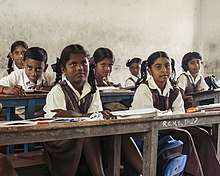
The first schools in Mayiladuthurai were founded by Christian missionaries in April 1819.[78] The Municipal High School constructed by the municipality between 1885 and 1893, was considered to be one of the premium educational institutions in the erstwhile Tanjore district.[21] As of 2011, there were 16 municipal elementary schools, five nursery & primary schools, five middle schools, one high school, two municipal higher secondary schools, two private higher secondary schools, one government higher secondary school, one government arts college, eight matriculation schools, one industrial training institute, one school for blind and one school for handicapped.[79] The A. V. C. College, A. V. C. College of Engineering, A. R. C. Vishwanathan College, C.I.I.T. Community College, Dharmapuram Adhinam Arts College, D. G. Government Arts College for Women, Mayiladuthurai Meenakshi Ramasamy Arts & Science College and Mayiladuthurai Community Centre are some of the important colleges in Mayiladuthurai.[80][81] All these colleges are affiliated to the Bharathidasan University in Tiruchirappalli.[81]
Transportation

The nearest international airport is the Puducherry Airport, located 116 km (72 mi) & Tiruchirappalli Airport, located 142 km (88 mi) from Mayiladuthurai while the nearest seaport is the Karaikal located 40 km (25 mi) away.
As of 2007, Mayiladuthurai municipality accommodated 87.54 km (54.39 mi) of roads: 5.6 km (3.5 mi) of cement roads, 75.8 km (47.1 mi) of bituminous roads, 3.46 km (2.15 mi) of WBM roads and 2.6 km (1.6 mi) of earthen roads. Additionally, there were 20.85 km (12.96 mi) of highways in the town.[82] The State Highways SH-23 and SH-64 pass through Mayiladuthurai.[83] There are 2 bus stands currently one serving Karaikkal, Nagapattinam, Thiruvarur routes and The other principal bus stand is located on the Kumbakonam-Sirkazhi SH-64 State Highway.[84][85] It has a total of 12 bus bays and rated class B as it has basic restaurant, toilet and lighting facilities.[84][85] There are regular bus services to important cities in Tamil Nadu.[83] There are also regular services to other South Indian cities like Bengaluru, Coimbatore, Madurai, Tirupati and Thiruvananthapuram.[83] Mayiladuthurai forms a part of the Division 1 of the Tamil Nadu State Transport Corporation which is headquartered at Kumbakonam.[86]
Mayiladuthurai is connected by rail with most important towns and cities in South India. Mayiladuthurai Junction railway station is located on the Main line connecting the state capital Chennai with Tiruchirappali. In Tiruchirappali division, this is one of the vital junctions after Tiruchirappali, Thanjavur as this generates huge revenue. There are lines to Tiruvarur and Karaikudi, making it one of the major junctions in the region. The Mysuru - Mayiladuthurai Express connects Mayiladuthurai, Kumbakonam, Thanjavur and Tiruchirappali with Mysuru and Bengaluru. There are regular express trains that connect the city with major cities in the state like Chennai, Coimbatore, Madurai and Tiruchirappalli.[87] There are passenger trains that connect Mayiladuthurai with Thanjavur, Tiruchirapalli, Thiruvarur,[88] Chidambaram and Viluppuram.[87][89]
Culture
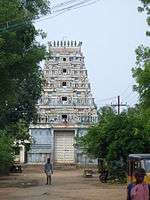
The Mayuranathaswami Temple complex was built during the time of the Medieval Cholas and is 719 ft (219 m) long and 520 ft (160 m) wide. The gopuram, the temple gateway tower, at the eastern entrance is 164 ft (50 m) high. Within the Mayuranathaswami temple, there is a carving of a devotee of Shiva trying to cut off his own head as an offering to the God.[90] The oldest inscriptions in the shrine date back to the reign of Kulothunga Chola I (1070–1120 CE).[91] The temple is maintained and administered by the Thiruvaduthurai Adheenam, a South Indian monastic institution.[92]
The Vallalar Koil or Medha Dakshinamurthy (Guru Bhagawan) Temple on the northern bank of the River houses an idol of the God Dakshinamoorthi mounted on a Nandhi. There is another idol of Nandhi at the Thula bathing ghat on the Cauvery River. Near by is Sri Kasi Viswanathaswami Temple on the southern bank of the river.
The Punukeeswarar Temple and Aiyaarappar Temple at Koranad, Mayiladuthurai are another important ancient Shiva temples in Mayiladuthurai.[93] Anandathandavapuram Panchavatiswarar Shiva Temple is located 5 km (3.1 mi) from Mayiladuthurai.[94]
The prominent Vaishnava temples in the town are Parimala Rangnathar Vishnu temple of lord Vishnu at Thiruvilandur on the northern banks of the Cauvery, a Divya desam and a Pancha rangam[95] and Kolikutti Vanamutti Perumal temple.
Dharmapuram Adeenam Mutt with ancient temples of Dharmapureswarar, Gnanapureeswarar, Ashta Dasapuja Durgadevi and Vana Durgadevi is located in the eastern suburb.
All the Hindu holy rivers in India are believed to converge in Mayiladuthurai every year on New moon day in the Tamil month of Aippasi (November–December). A bathe at the bathing ghats on the banks of the river Cauvery on this day, according to Hindu belief, relieves a man of all his sins and misdeeds as the waters of the holy Ganges river mix with the Cavery on this day.[1][96] Other important festivals celebrated at the temple are Navarathri, Adi Pooram, Avani Moolam, Karthigai Deepam and Vaikashi Brahmavotsavam[90] An yearly dance festival called the Mayura Natyanjali is conducted within the precincts of the Mayuranathaswami Temple by the Saptasvarangal Trust during Maha Shivaratri on the pattern of the Chidambaram Natyanjali festival.[97][98]
The town is considered the gateway to the Navagraha temple, the nine temples associated with planetary deities. The Periya Pallivasal mosque and TELC Church are other prominent worship places in the town. Tharangambadi, Pichavaram mangrove forest, Tirumullaivasal, Palaiyar and Karaikkal are the most prominent tourist attractions located around the town.[99]
Notable People
Some of the notable people from Mayiladuthurai include:
- Baskaran Adhiban, Indian Chess Player and Grandmaster[100]
- Viswanathan Anand, Indian Chess Player and Grandmaster[101]
- Kumari Kamala, Indian Dancer and Film Actor[102]
- T. Rajendar, Indian Film Actor, and former member of Tamil Nadu Legislative Assembly[103]
Notes
- Ayyar 1920, p 271
- Knapp 2011, p. 76
- Tamil Nadu Legislative Council 1971, p. 868
- Archaeological Survey of India 1969, p. 23
- T. S. Subramanian (1 May 2006). "Significance of Mayiladuthurai find". The Hindu. Chennai, India. Retrieved 17 May 2014.
- T. S. Subramanian (27 April 2008). "Megalithic pottery found". The Hindu. Chennai, India. Retrieved 17 May 2014.
- Swami 1939, p. 317
- Aiyangar 1919, p. 324
- Trivedi 1971, p. 53
- S. S. 1996, p. 125
- "Historical Moments: History of Mayuram". Mayiladuthurai Municipality. 2011. Retrieved 17 May 2014.
- "Nagapattinam District Home Page". Government of India. 2011. Retrieved 17 May 2014.
- K. 1974
- "Maps, Weather, and Airports for Madurai, India". Falling Rain Genomics, Inc. Retrieved 17 May 2014.
- "Chairman of Mayiladuthurai". Mayiladuthurai Municipality, Government of Tamil Nadu. 2012. Retrieved 1 January 2014.
- "Commissioner of Mayiladuthurai". Mayiladuthurai Municipality, Government of Tamil Nadu. 2012. Retrieved 1 January 2014.
- "Vice Chairman of Mayiladuthurai". Mayiladuthurai Municipality, Government of Tamil Nadu. 2012. Retrieved 1 January 2014.
- "MLA of Mayiladuthurai". Government of Tamil Nadu. 2012. Archived from the original on 6 October 2013. Retrieved 1 January 2014.
- "Members of Lok Sabha from Tamil Nadu". Government of Tamil Nadu. 2014. Retrieved 26 May 2014.
- "About Us". Mayiladuthurai Municipality. 2011. Retrieved 17 May 2014.
- Hemingway, p. 213
- "Commissionerate of Municipal Administration". Commissionerate of Municipal Administration. Archived from the original on 6 November 2012. Retrieved 1 January 2014.
- "Councillors of municipality". Mayiladuthurai municipality. 2011. Retrieved 1 January 2014.
- Economic and political weekly 1995, p. 2396
- "General Information". Mayiladuthurai Municipality. 2011. Retrieved 17 May 2014.
- "Budget 2010–11" (PDF) (in Tamil). Mayiladuthurai Municipality. Retrieved 1 January 2014.
- "Tamil Nadu Legislative Assembly Constituency map". Tamil Nadu Legislative Assembly. Archived from the original on 14 June 2012. Retrieved 17 May 2014.
- "Statistical Report of 1967 Tamil Nadu Assembly Elections" (PDF). Election Commission of India. 1967. Retrieved 17 May 2014.
- "Statistical Report of 1971 Tamil Nadu Assembly Elections" (PDF). Election Commission of India. 1971. Retrieved 17 May 2014.
- "Statistical Report of 1977 Tamil Nadu Assembly Elections" (PDF). Election Commission of India. 1977. Retrieved 17 May 2014.
- "Statistical Report of 1980 Tamil Nadu Assembly Elections" (PDF). Election Commission of India. 1980. Retrieved 17 May 2014.
- "Statistical Report of 1957 Madras Assembly Elections" (PDF). Election Commission of India. 1957. Retrieved 17 May 2014.
- "Statistical Report of 1962 Madras Assembly Elections" (PDF). Election Commission of India. 1962. Retrieved 17 May 2014.
- "Statistical Report of 1991 Tamil Nadu Assembly Elections" (PDF). Election Commission of India. 1991. Retrieved 17 May 2014.
- "Statistical Report of 2006 Tamil Nadu Assembly Elections" (PDF). Election Commission of India. 2006. Retrieved 17 May 2014.
- "Key highlights of 1984 Assembly elections" (PDF). Elections Commission of India. 1984. Retrieved 17 May 2014.
- "Key Highlights of 1996assembly elections" (PDF). Election Commission of India. 1996. Retrieved 17 May 2014.
- "Key Highlights of 2001 assembly elections" (PDF). Election Commission of India. 2001. Retrieved 17 May 2014.
- "List of Parliamentary and Assembly Constituencies" (PDF). Tamil Nadu. Election Commission of India. 2001. Archived from the original (PDF) on 6 February 2009. Retrieved 17 May 2014.
- "Key highlights of the general elections 1962 to the Third Lok Sabha" (PDF). Election Commission of India. p. 49. Retrieved 16 April 2011.
- "Key highlights of the general elections 1980 to the Seventh Lok Sabha" (PDF). Election Commission of India. p. 79. Archived from the original (PDF) on 18 July 2014. Retrieved 26 June 2012.
- "Key highlights of the general elections 1957 to the Second Lok Sabha" (PDF). Election Commission of India. p. 17. Retrieved 16 April 2011.
- "Key highlights of the general elections 1967 to the Fourth Lok Sabha" (PDF). Election Commission of India. p. 67. Retrieved 16 April 2011.
- "Key highlights of the general elections 1971 to the Fifth Lok Sabha" (PDF). Election Commission of India. p. 71. Retrieved 16 April 2011.
- "Key highlights of the general elections 1977 to the Sixth Lok Sabha" (PDF). Election Commission of India. p. 80. Retrieved 16 April 2011.
- "Key highlights of the general elections 1998 to the Twelfth Lok Sabha" (PDF). Election Commission of India. p. 85. Retrieved 16 April 2011.
- "Key highlights of the general elections 1999 to the Thirteenth Lok Sabha" (PDF). Election Commission of India. p. 85. Retrieved 16 April 2011.
- "Key highlights of the general elections 1996 to the Eleventh Lok Sabha" (PDF). Election Commission of India. p. 86. Retrieved 26 June 2012.
- "Key highlights of the general elections 1984 to the Eighth Lok Sabha" (PDF). Election Commission of India. p. 73. Retrieved 16 April 2011.
- "Key highlights of the general elections 1989 to the Ninth Lok Sabha" (PDF). Election Commission of India. p. 81. Retrieved 16 April 2011.
- "Key highlights of the general elections 1991 to the Tenth Lok Sabha" (PDF). Election Commission of India. p. 51. Retrieved 16 April 2011.
- "Key highlights of the general elections 2004 to the Fourteenth Lok Sabha" (PDF). Election Commission of India. p. 94. Retrieved 16 April 2011.
- "Obituary Reference". Parliament of India. 2011. Retrieved 17 May 2014.
- "Key highlights of the general elections 1991 to the Tenth Lok Sabha" (PDF). Election Commission of India. 1991. Retrieved 17 May 2014.
- "Key highlights of the general elections 1999 to the Thirteenth Lok Sabha" (PDF). Election Commission of India. 1999. Retrieved 17 May 2014.
- "Key highlights of the general elections 2004 to the Fourteenth Lok Sabha" (PDF). Election Commission of India. 2004. Retrieved 17 May 2014.
- "Water supply". Mayiladuthurai Municipality. 2011. Retrieved 17 May 2014.
- "Solid waste management". Mayiladuthurai Municipality. 2011. Retrieved 17 May 2014.
- Urban Infrastructure Report 2008, pp. 8-9
- "Storm water drainage". Mayiladuthurai Municipality. 2011. Retrieved 17 May 2014.
- "Mayiladuthurai hospitals". Mayiladuthurai municipality, Government of Tamil Nadu. 2011. Retrieved 1 January 2014.
- "Street lights in Mayiladuthurai". Mayiladuthurai Municipality, Government of Tamil Nadu. 2011. Retrieved 1 January 2014.
- "Mayiladuthurai Markets". Mayiladuthurai Municipality, Government of Tamil Nadu. 2011. Retrieved 1 January 2014.
- Census of India, 1931, p. 24
- Census of India, 1991, p. 548
- "Census Info 2011 Final population totals - Mayiladuthurai". Office of The Registrar General and Census Commissioner, Ministry of Home Affairs, Government of India. 2013. Archived from the original on 24 September 2015. Retrieved 26 January 2014.
- "Census Info 2011 Final population totals". Office of The Registrar General and Census Commissioner, Ministry of Home Affairs, Government of India. 2013. Retrieved 26 January 2014.
- Urban Infrastructure Report 2007, p. 3
- Urban Infrastructure Report 2007, p. 5
- Urban Infrastructure Report 2007, p. v
- "Mayiladuthurai: Mani means business". India Today. 16 (7–12). 1991.
- "Population By Religious Community - Tamil Nadu" (XLS). Office of The Registrar General and Census Commissioner, Ministry of Home Affairs, Government of India. 2011. Retrieved 13 September 2015.
- "Industry". Mayiladuthurai Municipality. 2011. Retrieved 17 May 2014.
- South Indian Railway Co. Ltd. 1926, p. 52
- W., p. 160
- "Markets and commercial complexes". Mayiladuthurai Municipality. 2011. Retrieved 17 May 2014.
- "Banks and ATM Centres". Mayiladuthurai Municipality. 2011. Retrieved 17 May 2014.
- Church Missionary Society 1825, p. 79
- "Schools in Mayiladuthurai". Mayiladuthurai Municipality. 2011. Retrieved 17 May 2014.
- Commonwealth universities yearbook 2003, p. 737
- Gupta 2006, p. 123
- Urban Infrastructure Report 2007, p. 9
- "How to reach". Mayiladuthurai Municipality. 2011. Retrieved 17 May 2014.
- "Bus Stand". Mayiladuthurai Municipality. 2011. Retrieved 17 May 2014.
- Urban Infrastructure Report 2007, p. 10
- "Tamil Nadu State Transport Corporation (KUM DIV-I) Ltd., Kumbakonam". Government of Tamil Nadu. Retrieved 17 May 2014.
- "Train availability at stations". Indian Railways. 2012. Retrieved 16 November 2012.
- "Passenger trains to be run on Mayiladuthurai-Tiruvarur line". The Hindu. Tiruchi. 11 May 2013. Retrieved 20 May 2014.
- "Passenger trains to Mayiladuthurai, Katpadi, flagged off at Villupuram". The Hindu. Villupuram. 30 March 2013. Retrieved 20 May 2014.
- "Sri Mayuranathar temple". Dinamalar. Retrieved 16 April 2011.
- Ayyar 1920, p 280
- Krishna 2002, p. 227
- "Places of Interest". Mayiladuthurai Municipality. 2011. Archived from the original on 20 September 2012. Retrieved 17 May 2014.
- "Consecration at Anandathandavapuram". The Hindu. Chennai, India. 14 April 2011. Retrieved 17 May 2014.
- Ayyar 1920, p 281
- Ayyar 1920, p 249
- "Mayura Natyanjali". Saptasvarangal Trust. Retrieved 17 May 2014.
- "Brilliant show by Chennai dance school students". The Hindu. Chennai, India. 4 May 2009. Retrieved 17 May 2014.
- "Places of tourists". Mayiladuthurai Municipality. 2011. Retrieved 17 May 2014.
- "Adhiban, Vishy hail from Mayiladuthurai". The New Indian Express. Retrieved 20 July 2020.
- DelhiDecember 11, India Today Web Desk New; December 11, 2015UPDATED:; Ist, 2018 14:40. "Viswanathan Anand: Important facts about the Indian chess 'grandmaster'". India Today. Retrieved 20 July 2020.CS1 maint: extra punctuation (link) CS1 maint: numeric names: authors list (link)
- "Kumari Kamala : Kannada Choreographer Age, Movies, Biography". chiloka.com. Retrieved 20 July 2020.
- "Thesingu Rajendar". IMDb. Retrieved 20 July 2020.
References
- Knapp, Stephen (2011). Spiritual India Handbook. Mumbai: Jaico Books. ISBN 978-81-8495-024-3.
- Gupta, Ameeta; Kumar, Ashish; Kumar, Ashish (2006). Handbook of Universities, Volume I. Atlantic Publishers & Dist. p. 123. ISBN 9788126906079.
- Commonwealth universities yearbook, Volume 1. Association of Commonwealth Universities. 2003. p. 737.
- Church Missionary Society (1825). Missionary register, Volume 13. Seeley, Jackson, & Halliday.
- W., Francis. Gazetteer of South India. p. 160.
- Illustrated guide to the South Indian Railway (Incorporated in England): including the Tanjore District Board, Pondicherry, Peralam-Karaikkal, Travancore State, Cochin State, Coimbatore District Board, Tinnevelly-Tiruchendur, and the Nilgiri Railways. South Indian Railway Co. Ltd. 1926.
- Census of India, 1931, Volume 1, Part 2. Manager of Publications. 1933. p. 24.
- Census of India, 1991: B Series. Economic tables. v. 1-2, v. 2 pt. 2, v. 3, pt. 1-2. Manager, Govt. of India Photolitho Press. p. 548.
- Krishna, Nanditha (2002). Sacred tanks of South India. C.P.R. Environmental Education Centre.
- K., Chockalingam (1974). Census of India, 1971 D: Migration Tables. Manager of Publications.
- S. S., Shashi (1996). Encyclopaedia Indica: India, Pakistan, Bangladesh, Volume 100. Anmol Publications. ISBN 9788170418597.
- Trivedi, Krishnaji (1971). Mahatmas: acharyas, mystics, saints, sages, seers. Shivaji News Printers.
- Aiyangar, S. Krishnaswami (1919). Sources of Vijayanagar history. University of Madras. p. 324.
- Swami, Sadananda (1939). Origin and early history of Śaivism in South India. University of Madras. p. 317.
- Indian archaeology: a review (PDF). Archaeological Survey of India. 1969.
- Hemingway, F. R. Madras District Gazetteers: Tanjore. p. 213.
- The Imperial Gazetteer of India 1908, Vol 17. Clarendon Press. 1908. pp. 237–238.
- Debates, Official Report, Volume 89. Tamil Nadu Legislative Council. 1971.
- P. V. Jagadisa Ayyar (1920). South Indian shrines: illustrated. Madras Times Printing and Pub. Co.
- Urban Infrastructure report (2007). Conversion of City Corporate Plan into Business Plan (PDF) (Report). Tamil Nadu Urban Infrastructure Financial Services Limited.
External links
| Wikimedia Commons has media related to Mayiladuthurai. |
